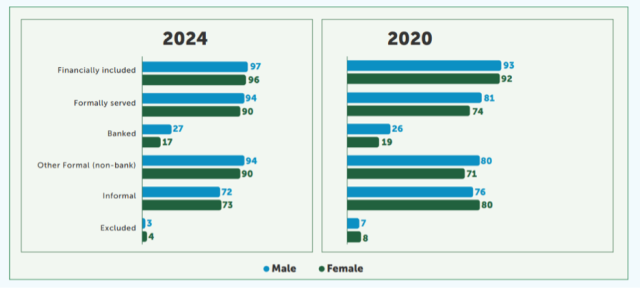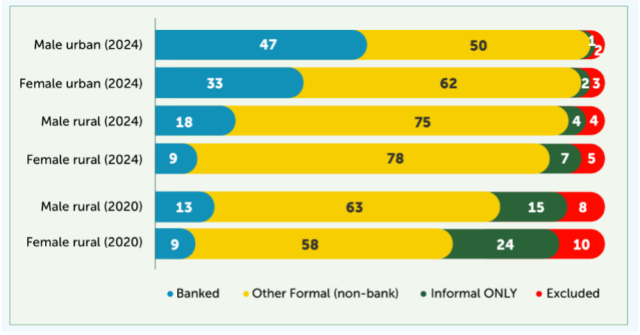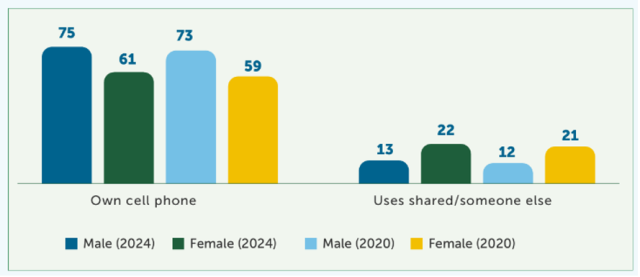Rwanda’s path to inclusive finance: gender insights from the FinScope thematic report
Rwanda 07.07.2025 Project
©AFR

The Luxembourg Cooperation is working alongside Rwanda to promote inclusive and innovative finance, notably through its support to the Kigali International Finance Centre (KIFC). In 2024, this partnership contributed to Rwanda’s national FinScope survey — an initiative led by Access to Finance Rwanda that examines how Rwandans access and use financial services. Among its key thematic reports is one on gender and financial inclusion, spotlighting both progress towards narrowing the gender financial gap and persistent barriers hindering women’s financial inclusion.
Progressing towards gender-equal financial inclusion
Between 2020 and 2024, the proportion of women financially included has increased from 92% to 96%, while the proportion of men financially included has increased from 93% to 97%. Consequently, the overall financial gender gap remained at just one percentage point in 2024.
There has been a steady increase in formal financial inclusion, covering both bank and non-bank services. Between 2020 and 2024, the proportion of women using formal financial services rose from 73% to 90%, while the proportion of men using such services increased from 81% to 94%. This suggests that the gender gap in formal financial services has narrowed down to 4% in 2024, compared to 7% in 2020.
However, significant gender disparities remain in the use of financial services. The main barriers to women adopting banking services are limited demand for accounts and insufficient income to open them. Nevertheless, women’s reliance on informal financial services has dropped significantly, from 19% in 2020 to 6% in 2024.
-
In 2024, only 17% of women had access to banking, compared to 27% of men.

©AFR
Overview of financial products or services uptake by gender (%)
Exploring the factors influencing women's financial inclusion
The report examines the various factors that determine women’s financial inclusion. It highlights how factors such as geographic location, educational attainment, age, and employment status (including income level) intersect with gender to affect women’s access to financial services.
Comparing rural and urban financial access
According to the 2024 statistics, 33% of women in urban areas have access to banking services, compared to just 9% in rural areas. Between 2020 and 2024, the proportion of rural women using other formal financial services, such as mobile money, rose from 58% to 78%. Furthermore, the rate of financial exclusion for women in rural areas fell from 10% to 5%. While this indicates significant progress in improving financial inclusion for rural women, they continue to be the most financially excluded group.

Financial inclusion by urban or rural area (%)
Financial inclusion by level of education
Regarding educational attainment, the rates of banking services adoption are highest among women and men who have achieved up to tertiary or vocational education. This group also has a null rate of financial exclusion, whereas financial exclusion is naturally highest among those with no education.
Driving factors of financial inclusion: the role of mobile money
High rates of formal financial inclusion are mainly driven by the widespread adoption of formal non-bank services, such as mobile money.
-
Between 2020 and 2024, the percentage of women with a registered account increased from 55% to 73%.
However, accessing mobile money services requires both a mobile phone and, in some cases, internet access, which both continue to be significant gender barriers.
In 2024, only 61% of women owned a mobile phone, compared to 75% of men. Between 2020 and 2024, access to mobile phones has increased by only 2 percentage points for both genders.

Mobile phone access (%)
Conclusion
While this report shows progress in closing the gender gap in financial inclusion, it also reveals ongoing disparities that continue to limit women’s full access to financial services and economic empowerment. To achieve gender-equal financial inclusion, structural issues must be addressed. These include limited employment opportunities, unequal income, lower levels of education, restricted decision-making power, harmful gender norms, and a lack of financial and digital literacy, as well as unequal access to technology.
About the project
The Support to the development of Kigali International Finance Centre project is financed by the Grand Duchy of Luxembourg and implemented by LuxDev, the Luxembourg Development Cooperation Agency.
Explore more
Discover the latest news from LuxDev and stay updated on the progress of cooperation projects and programmes implemented by the Agency.
All news-

Laos 23.12.2025
Building the future: outcomes of the Infrastructure Development Fund in Bolikhamxay
Building the future: outcomes of the Infrastructure Development Fund in Bolikhamxay -

Laos 23.12.2025
Luang Prabang unveils revitalised Hospitality Training Centre to enhance skills and career prospects
Luang Prabang unveils revitalised Hospitality Training Centre to enhance skills and career prospects
